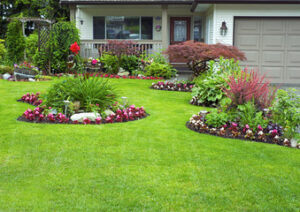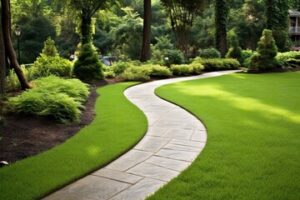A well-kept landscape makes your home or business more appealing to visitors and potential buyers. It also reflects that you care about your property and take the time to maintain it.

Hardscaping involves changing the terrain of your yard by adding or removing material. It can include features like patios, walkways and retaining walls. Visit https://www.primecutlawnky.com/ to learn more.
The word “aesthetic” is derived from the Greek words (aisthetikos) and (esteikos). It is used to describe the appearance of an object, person, or idea. It is also used to describe how people perceive beauty and taste. It is often confused with the word esthetics, but the two are different. The etymology of both words is the same, but they have different connotations.
Aesthetics is a branch of philosophy that studies the nature, expression, and perception of beauty. It is considered a liberal art, and it is important in the lives of many people. It has a great impact on the way we live, work, and play. It is also a major part of the cultural identity of a nation or region.
The aesthetics of landscaping is a combination of horticultural science, spatial organization, and artistic composition. It involves the use of various colors, plant sizes, shapes, and textures to create a harmonious environment. It can be achieved by using a variety of hardscaping and softscaping features, such as paths, walls, and water features.
To create a pleasing visual harmony, the landscape designer must consider balance and proportion. Balance is created by arranging elements of equal size, shape, and color on either side of a central point or axis. This can be done by using symmetrical balance, which has a formal look, or asymmetrical balance, which has a more natural feel.
Repetition is another technique used in landscape design to add interest and create unity. It can be achieved by lining up similar plants or objects in a row, or by placing geometrical shapes such as squares in an orderly arrangement. It is important to be careful when using repetition because too much can lead to boredom.
The aesthetics of landscaping is a broad topic that has inspired a lot of thought and discussion. One of the most important concepts is the nature of aesthetic value, which is based on the perception of an object’s beauty and pleasure. This concept is difficult to define, but it can be described as a subjective and personal experience.
Function
The purpose of landscaping is to beautify a building or an area and make it a joyful place for people to live. It involves planning the drives, walks, gardens, shrubbery, flower-beds etc. around a house, office or a commercial building to make it attractive and pleasant. It also helps to improve the overall appearance of the area and enhances its value.
Moreover, it contributes to the environmental health of an area by providing an environment for a variety of wildlife. It prevents soil erosion, reduces carbon dioxide levels and other pollutants in the air. It also protects water sources and habitats for animals. In urban areas, it can help to control runoff and sedimentation.
Landscaping services can be used to improve the aesthetic of a property by trimming bushes and trees, re-edging gardens, or installing new plants and structures. This can increase a home’s curb appeal and make it more appealing to potential buyers if the owner decides to sell it. It can also create a relaxing space for entertaining guests and spending time with family.
In addition, a well-planned landscape can increase a home’s value by up to 12%. It can also encourage neighbors to maintain their properties. In fact, beautiful parks and green spaces attract tourists and residents alike. They can even help to improve the environment and people’s mental health by reducing stress levels, improving memory, and promoting feelings of happiness and wellbeing.
Aside from boosting a home’s curb appeal, landscaping can also provide practical benefits, such as enhancing privacy and reducing noise pollution. It can also improve a home’s drainage system and water retention capabilities, as well as reduce erosion and flood risk. It can even provide an opportunity for horticulture, such as growing fruit trees and vegetables.
While the current trend is to allow nature to take the lead, a successful design should strike a balance between dwelling and natural setting. This can be done by introducing focal points to the garden or yard. For example, the placement of a pergola or bench can draw attention to a particular part of the garden and enhance the view. Adding lighting can also help highlight features and create an ambiance that is both inviting and peaceful.
Maintenance
Landscape maintenance is more than just upkeep of your beautiful new landscaping; it’s about keeping it at its best and helping it reach its full potential. The key to this is consistent care that addresses all the needs of your yard or garden. Some of these needs are obvious, such as mowing and trimming lawns, while others are more complex and involve things like disease management and pest control.
Landscaping services include the installation, repair, and modification of outdoor features such as trees, shrubs, flower beds, and garden areas. They also include hardscapes, such as patios, walkways, driveways, and fences. These are often constructed with materials such as wood, stone, concrete, and brick and can be customized to fit your space. In addition to providing a pleasant aesthetic, these features can increase the value and usability of your property.
When Does Landscaping Become Construction?
While landscaping includes many types of activities, some may be considered construction projects. This is because they alter the land in order to make it more functional. For example, improving drainage or raising certain areas of your property could be considered landscaping construction because it improves the functionality of your home. It’s important to work with a licensed and experienced landscaping company when considering construction projects for your property.
The most common types of landscaping construction are hardscapes and softscapes. Softscapes refer to the plants and flowers in your garden, while hardscapes are the paved or built elements of your yard. Examples of hardscapes are paths, walkways, patios, and retaining walls. Some of these structures are incorporated into the landscape design while others stand on their own.
The purpose of landscaping is to create a relaxing and peaceful environment in which you can unwind. It’s been shown that spending time in nature lowers blood pressure, increases endorphins, and helps people feel happier and healthier. In addition, a well-maintained landscaping project will add value to your property and help keep you safer. It’s important to have a team of experts by your side to assist you with the design and building process, and then to maintain the final product.
Safety
The safety measures taken by landscapers can make all the difference in the world. A shaky ladder can cause injuries, and the jagged edges of a chainsaw or other hand tool can cut or even dismember a worker who is not wearing proper safety gear. The National Association of Landscape Professionals (NALP) focuses on safety throughout the year, and offers members a Safety Tailgate Training Manual, multiple annual safety webinars, and safety adviser services. Landscaping companies also typically offer extensive safety training to all new employees and emphasize employee training during the hiring process with formal tests, screenings, and orientations.
Planting is a large part of a landscaping job and poses several risks. The most common hazards include falling or rolling objects, back injury from heavy lifting, and heat stress. Employees should follow safe work practices, take frequent breaks with water and food available, and wear a face mask and eye protection when spraying chemicals. They should have a spotter or colleague support their movements while on ladders, and use caution when moving heavy plants. They should keep vehicles and equipment fueled and secure, and report unsafe conditions to their supervisors.
Maintenance involves mowing, pruning, fertilizing, weed control, and blowing debris. Workers can be exposed to chemical and physical hazards, including cuts and amputations, respiratory disease, hearing loss, and vehicle accidents. They should wear gloves, safety goggles while working with blowers, and ear protection when using mowers. They should wear high-quality, comfortable work shoes, and have access to water and food. They should report any unsafe working conditions to their supervisors, and make sure they have a first aid kit and know where emergency telephone numbers are located.
In addition to a host of health benefits, green spaces can decrease crime. Studies show that areas with more tree coverage have lower rates of violent crime, while well-maintained yards and parks increase property values. With the right approach, a business owner can maximize the benefits of their landscaping investments while mitigating any potential risk factors. By focusing on safety, landscapers can protect their clients, their workers, and their assets.
